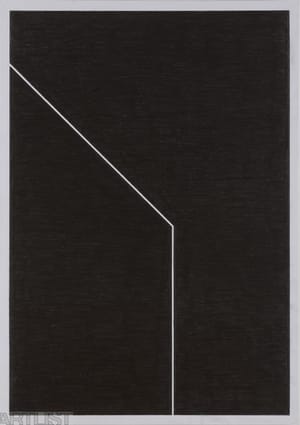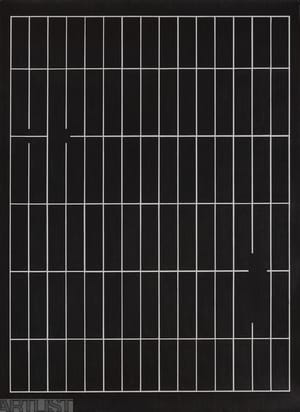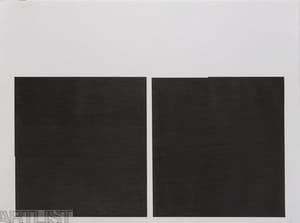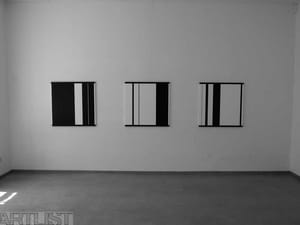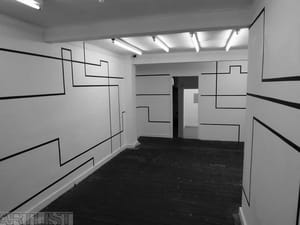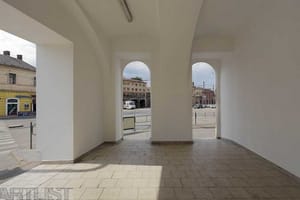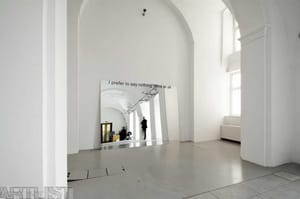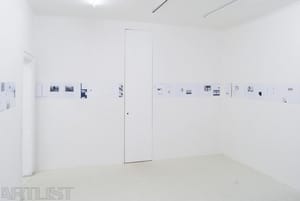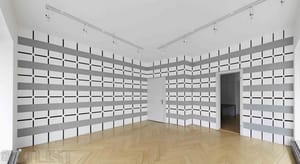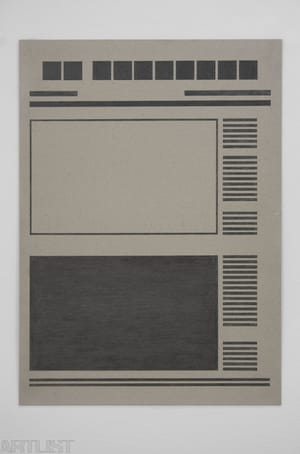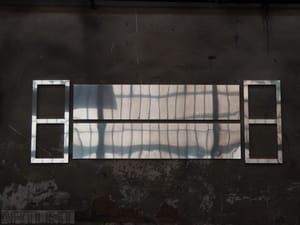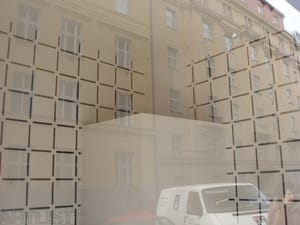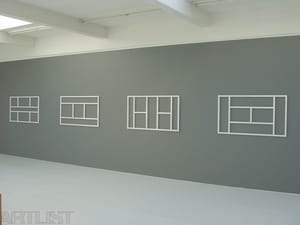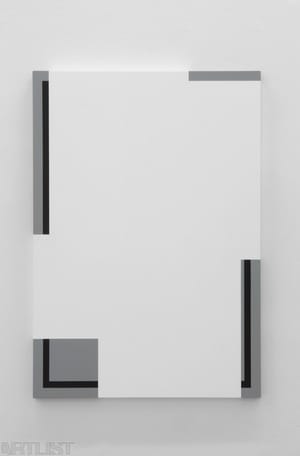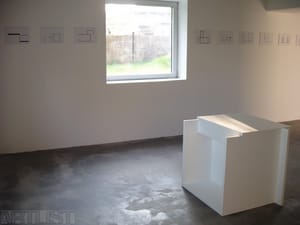- First Name
- Michal
- Surname
- Škoda
- Born
- 1962
- Birth place
- Tábor
- Place of work
- Soběslav
- CSU Library
- ↳ Find in the catalogue
About artist
The work of Michal Škoda, while unusually compact, is not exhausted by the apparent variations of modernist principles of the exploration of form. Škoda critiques these principles by expanding the space of the media on which he concentrates. Geometry in painting, drawing or installations express the conflict of rules which the artist discovers in observed reality, most often within an architectural environment. He does not restrict himself to copying its external style, but attempts to uncover its construction and free it of sediments. In this way he shows a system which can no longer be used and therefore is breaking away, becoming empty. At the Brussels Biennale (2008) the work comprised only a frame, the overarching levels of unseen details. The grey wall created the basis thanks to which it was possible to distinguish the work from the wall, but covered the putative original contents of the frame which it displayed.
The backdrop of Škoda’s art needs no deciphering, since the artist anticipates the viewer’s curiosity: the movement of detection takes place in relation to the observed. Not even in this kind of project, which is to a certain extent a journal (the exhibition Records in the Photography Gallery, 2010), is the viewer the person who inspects the artistic motives. Škoda is interested in more abstract principles which include the situation of viewing itself. The collages exhibited here were a continuation of his interest in the medium of the book or the contexts of words without written discourse: capturing their structure, the organisation which lost the primary information. He presented this line for instance in the Šternberk Gallery at the exhibition Works on Paper (2005).
Despite the austerity and precision of depiction in his works, the artist evokes feelings of a tireless examination and the need to find fragments of the rules of society in which we live. Every one of his works establishes a relationship-based situation, which the artist acquires from our external conditions. He reduces the situation to the purest geometrical forms. Through their similarity to furniture, to a book, to a building facade or ground plan he illustrates the perspective of his investigation. The installations in the Vernon Gallery (2008) and in Basel (2009) brought into the interior of the gallery a general pattern which might be reminiscent of parts of building exteriors. It was not important to make out the concrete models, but to perceive the lack of the connecting points which we expect on the basis of our civilised collective experience. The artist often adds an element to the created whole (which can also be its absence), which cleanly but nevertheless parasitically squeezes into the existing grid. This takes place either inside the installation itself or as a consequence of the context in which the work is exhibited. Škoda created the most open connection with the environment at the Prague Biennale (2009), where the iron construction of the windows of a former factory was reflected in a metal geometrical object. He opted for a similar approach in the project Billboard Prague (2008), in which he pasted a black and white composition on a space for billboards near highways. This could be taken as a conflict of two carriageways, the corners of a junction, or a special transport sign.
In the Wannieck Gallery, Brno, in 2007 he undertook a joint project with Jan Šerých entitled Icing (Forbidden Release). The artists worked with the symmetrical division of the surface of pictures, whose final parameters were created by overlapping six designs by Michal Škoda and six by Jan Šerých. The resulting surfaces or patterns were executed in a black and white geometrical form favoured by both artists.
- Author of the annotation
- Markéta Kubačáková
- Published
- 2010
CV
2005 – TRANZIT CZ – Vývojový grant – Praha
Exhibitions
- Solo exhibitions
-
(selected exhibitions since 1997)
2014
PROSTŘEDÍ ČASU - Centrum nové architektury – Ostrava
PŘÍTOMNOST ABSENCE – Galerie Na shledanou – Volyně
V SEDĚ I VE STOJE – Galerie Jelení - Praha
2013
PROSTŘEDÍ ČASU – Drdova Gallery – Praha
JOLANA HAVELKOVÁ / MICHAL ŠKODA – MIMO PLÁN – Galerie Fiducia – Ostrava
2012
MICHAL ŠKODA /JAN MAARTEN VOSKUIL - BETWEEN CORNERS – Topičův klub – Praha
2011
RECORDS - Galerie města Blanska – Blansko
ABOUT – Elisabeth Grübl – Michal Škoda – Rakouské kulturní fórum - Praha
EVERYBODY LOOKS FOR A PLACE TO DANCE – Studio 1-1 Gallery – London / UK /
UNTITLED – České kulturní centrum – Wien / A /
2010
RECORDS – Galerie Fotografstudio - Praha
NENÍ TO, ČÍM ZDÁ SE BÝT – Galerie die Aktualität des Schönen… - Liberec
A – Gallery – Amsterdam / NL /
2009
KDE JEŠTĚ NIKDO NEBYL……. – Galerie Sleeper – Edinburgh / UK /
Hebel 121 – Basel / CH /
THEY SAID I SAID – Studio 6.15 – Zlin
2008
PS Projectspace – Amsterdam / NL /
Project space – CCNOA – Brusel / B /
DO YOU KNOW WHAT I WAS THINKING … – Konsortium – Duesseldorf / D /
Concept space – Shibukawa / J /
BETWEEN – Vernon projekt – Praha
2007
INSIDEOUTSIDE – Galerie AP Atelier – Praha
JAN ŠERÝCH / MICHAL ŠKODA – ZAKÁZANÉ UVOLNĚNÍ – Wannieck gallery – Brno
2006
RESONANCE – Centrum nové architektury – Ostrava
MICHAL ŠKODA – Galerie Komart – Bratislava / SK /
2005
PRÁCE NA PAPÍŘE – Galerie Šternberk – Šternberk
Dům umění – Brno
2004
MICHAL ŠKODA 2000 – 2003 – Národní galerie / Veletržní palác / - Praha
2003
FOLDING STRUCTURES – České centrum – Londýn / s K.Štenclovou / / GB /
KRESBY – Galerie Pecka – Praha
2002
MOMENTY VNIMÁNIA – Galéria J.Koniarka – Trnava / SK /
KDESICOSI – Galerie Emila Filly – Ústí nad Labem / s E.Výbornou /
2001
SELECTED AFFINITIES - České centrum – New York / s K. Štenclovou / / USA /
BÍLÁ VYMEZENÍ – Moravská galerie / Atrium Pražákova paláce / - Brno
2000
VYMEZENÍ - Galerie U Bílého jednorožce – Klatovy
NA STĚNĚ – Výstavní síň Telecom – Louny
ČTRNÁCT - Galerie Langův dům – Frýdek Místek
1999
Galerie Die Aktualität des Schönen…- Liberec
KRESBY- Galerie Pecka - Praha
1998
Galerie U Dobrého pastýře – Brno
Sorosovo centrum souč. umění - Praha
Galerie Felixe Jeneweina - Kutná Hora
1997
Milevské muzeum - Milevsko
Galerie Pecka - Praha
- Group exhibitions not included in ARTLIST.
-
(selected exhibitions since 1996)
2014
DYSTOTAL – Pori Art Museum – Pori / FIN /
ZE STŘEDU VEN – Západočeská galerie – Plzeň
PS 1999 – 2014 – PS Project Space – Amsterdam / NL /
2013
INGREDIENTS – Riga Art Space – Riga / LV /
OTEVŘENÁ KNIHA – DOX : Centrum souč.umění - Praha
2012
DOMANI PROJECT – Concept Space – Shibukawa / J /
OSTROVY ODPORU – Národní galerie – Praha
COLLABORATIONS AND INTERVENTIONS – CCA Kunsthalle – Andratx (Mallorca) / Spain /
SITUATION 57 / D.Buren, S. Le Witt, F.E.Walther, M.Skoda / - Bleibtreu Gallery - Berlin
2011
ČESKÁ MALBA GENERACE 90.LET – Dům umění - Brno
ZTIŠENÍ – Wannieck Gallery - Brno
VI.NOVÝ ZLÍNSKÝ SALÓN - Zlín
BRNO ART OPEN - Brno
VERBALE 2 – Esther Stocker Studio -Wien / A /
4+4 DNY V POHYBU / 16. FESTIVAL SOUČ.UMĚNÍ – Praha
2010
COMPOSITE VISIONS – CAN –Neuchatel / CH /
2009
PS 1999 – 2009 – Kunstruimte – Groningen / NL /
MY EUROPE / Contemporary Czech Art and Design – EESC - Brussels / B /
MOJE EVROPA / Současné České umění a design / - DOX - Praha
UND 5..et voila..- Maison Abandonnee – Nice / F /
Prague Biennale 4 - Praha
2008
UNDER THE SURFACE – RC de Ruimte – Ijmuiden /NL/
UND 4 CROXHAPOX – Croxhapox – Gent / B /
FARBY LUCKY – Nitrianská galéria – Nitra / SK /
GEGENSTANDLOSS - GKG – Bonn / D /
BARVY LAKY – Galéria Jána Koniarka – Trnava / SK /
1th Brussels Biennial // YO, MO´ MODERNISM…at CCNOA // - Brussels / B /
2007
AŽ NA VYJÍMKY NOVÉ – Wannieck gallery, Brno
ČESKÁ MALBA 80. A 90. LET / ČÁST II. / - Wannieck gallery – Brno
PAS DE SOUCIS…- Non Objectif Sud – Tulette / F /
A BIT Ó WHITE – CCNOA – Brusel / B /
2006
ČESKÁ MALBA 1985 – 2005 – Wannieck gallery – Brno
2005
FUNKEHO KOLÍN – Kolín
ARGUMENTA – Atlas Sztuki – Lodz / PL /
40 POSITIONEN 31 RAUME – Modern Art Museum – Hűnfeld / D /
TINA.B – FESTIVAL SOUČASNÉHO UMĚNÍ – Praha
2003
EJHLE SVĚTLO – Moravská galerie – Brno
2002
MONOCHROMIE – České muzeum výtvarných umění – Praha
ARtCHITEKTURA – Galerie Jaroslava Frágnera – Praha
2001
LABORATOŘ SOUČASNÝCH TENDENCÍ – Národní galerie / Veletržní palác / - Praha
KAMENY A HVĚZDY – Areál Hvězdárna – Ondřejov
15. MEZINÁRODNÍ VÝSTAVA KRESBY – Muzeum moderního umění - Rijeka / HR /
2000
ČESKÁ KAMENNÁ SKULPTURA – Pražský hrad - Praha
4. MEZINÁRODNÍ MAPOVÁNÍ PROSTORU – Galerie Klatovy / Klenová - Klenová
1999
II. NOVÝ ZLÍNSKÝ SALÓN – Zlín
1997
Museum – Milevsko
1996
ARTIST CAMP IN ASO – Oguni / J /
ARTIST CAMP IN KASAMA – Kasama / J /
- Collections
-
KENNEDY MUSEUM OF AMERICAN ART – Athens / Ohio / / USA /
SCULPTURE PARK – Kasama - / J /
SPARKASSE – Passau / D /
MORAVIAN GALLERY – Brno
NATIONAL GALLERY - Prague
THE CENTER OF POLISH SCULPTURE – Oronsko / PL /
MUSEUM OF ART – Olomouc
CHICAGO ART INSTITUT / Artist´s Books Collection / - Chicago / USA /
WANNIECK GALLERY / RICHARD ADAM COLLECTION / - Brno
MILAN DOBES MUSEUM – Bratislava / SK /
KLATOVY / KLENOVÁ GALLERY – Klatovy
- Other realisations
Public Art Projects:
2008 EMERGING WOR(L)DS / Billboard text Art / - Prague
2004 OPEN BOOK – Hünfeld /D/
Monography
- Authored texts included in database
